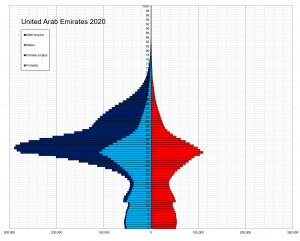18 North Africa & the Middle East: Population Geography I –
Skewed Sex Ratios from Migration

The sex ratio is a very useful and flexible demographic statistic. This measurement considers the balance between males and females in a population, usually expressed as males per 100 females. A low sex ratio is fewer than 100 males for each 100 females, while a high sex ratio shows more than 100 males for each 100 females.
There are numerous factors that affect the sex ratio. Today primarily we will consider labor force trends that may increase the sex ratio when the dominant job markets seek males. For instance, jobs in resource extraction typically are held by men. In the USA, this is true in Alaska and in several Western states. This type of employment pattern can raise sex ratios. In the Middle East, this labor force pattern has generated high sex ratios in oil fields, construction, and business, so that several countries have strikingly higher male populations than female populations. We will focus on the United Arab Emirates (UAE).
The UAE is a federation of emirates, in which each emirate is ruled by a sheikh. In 1971 the emirates became an independent country, transitioning from its status as a British protectorate. Abu Dhabi holds the country’s capital city, while Dubai is a major center of international commerce. Of the emirates, Abu Dhabi is the largest in area, in oil production, and in overall gross domestic product (GDP). Indeed, oil transformed the UAE economically. Having the world’s seventh largest deposits of oil caused the economy to skyrocket. Financial diversification and investment prompted the UAE to become a focal point of international commerce.

With economic growth, the population of UAE surged also. In 1975 the emirates held only 550,000 people, yet the population reached nine million by 2011. Since then, growth has slowed dramatically, with only an additional one million increase in the subsequent decade. Some of this growth was due to the usual demographic balance of more births than deaths; however, in the UAE a vast majority of this increase came from international migration for the labor force.
Who came to the UAE to work? In earlier days, the emirates even had immigrants from Europe, in recent years nearly all migrant workers have been from the Middle East and various regions of Asia, with South Asian countries providing the highest number of migrants. While the current population is 9.99 million in the UAE, workers from both India and Pakistan outnumber UAE nationals.
| Country of Origin | Population in millions |
|---|---|
| India | 2.75 |
| Pakistan | 1.27 |
| UAE itself | 1.15 |
| Bangladesh | 0.75 |
| Philippines | 0.56 |
| Iran | 0.48 |
| Egypt | 0.42 |
| Nepal | 0.32 |
| Sri Lanka | 0.32 |
| China | 0.21 |
Who came to the UAE to work? Men did. In earlier days, migrant workers stormed into the oil fields, essentially 100% men as needed for rugged work. Employment in the oil sector in Abu Dhabi remains important and still belongs to men; however, as commerce broadened particularly in Abu Dhabi and Dubai, a variety of commercial and management opportunities opened for immigrants. These too remained mostly male jobs, but women did find opportunities in retail trade and as domestic servants and personal assistants. Although education of women has increased, corresponding advances in careers have not always followed.

Here we see the population pyramid for UAE for 2020. Note the overwhelming imbalance in the sex ratio, so many more men than women. Carefully observe that regarding children, the male surplus is simply biological. Although non-intuitive to contemplate, due to human biology, the sex ratio at birth is normally about 105. Again, that would mean that approximately 105 boys are born for every 100 girls born. While it seems that the sex ratio at birth ought to be 100 (it’s a boy or a girl, thus seemingly even odds), this is not the case. Given that males die at every age more often than females, males need the head start in the biological run. Actually, the race begins even before conception, as the sex ratio at conception is about 115. This means that countries with high birth rates will have a higher share of children (more boys than girls, because of the birth head start) in their populations, thus a high sex ratio.
Therefore, in the UAE we see a few more boys than girls, due simply to this biological head start. However, the huge imbalance in the sex ratio there is in the labor force. In traditional years of labor force participation, men vastly outnumber women. Starting at about age 30, men double women in the population. Even though the population of women by age groups peaks at about 110,000 at age 34, men of the same age top 270,000. At age 51, some 20,000 women are swamped by 50,000 men.
Aging of a population lowers its sex ratio, as biologically women live longer than men, hence the head start given to baby boys. However, the labor force edge that men hold in UAE keeps the male edge in the sex ratio until about age 85 from whence the sex ratio looks to be even for the few people living past that age milestone.
For a number of years, the UAE has used a work visa sponsorship program to allow migrants to arrive in the country and to begin working while also taking steps to continue to stay. Reports of human rights abuse have prompted legislation to address these concerns. The organization Human Rights Watch has cited a number of concerns, such as confiscation of passports, incomplete payments of wages, mandatory overtime, and physical abuse. The COVID-19 pandemic has affected labor forces around the world; whereas in the UAE, many migrant workers have lost their jobs, in some cases becoming homeless.
The United Arab Emirates is a distinctive country, riding oil riches to diversify economic opportunities and trade, while importing workers, primarily men, who matched advances in employment sectors. Thus, two demographic characteristics are greatly out of balance in the UAE. Males vastly outnumber females, while number of foreigners is much higher than UAE nationals.
Did you know?
Here are the countries with the six highest sex ratios. These top six all are countries in NAME.
| Country | Sex Ratio |
|---|---|
| Qatar | 3.39 |
| UAE | 2.56 |
| Bahrain | 1.53 |
| Kuwait | 1.38 |
| Saudi Arabia | 1.30 |
| Oman | 1.13 |
By the way and in contrast, the countries with the world’s lowest sex ratios mainly are the western of the Soviet republics that became countries with the dissolution of the Soviet Union. That would be Russia, Ukraine, Belarus, and the three Baltic States – Estonia, Latvia, and Lithuania. These countries have six of the eight lowest sex ratios.
Hot Off the Press
https://tinyurl.com/QatarWorkers
This article of September 20, 2022, from The Guardian, highlights the woes of foreign workers in Qatar.
Cited and additional bibliography:
Hesketh, T., and Z. W. Xing. 2006. “Abnormal Sex Ratios in Human Populations: Causes and Consequences.” Proceedings of the National Academy of Sciences 103 (36): 13271–75. https://doi.org/10.1073/pnas.0602203103.
Kluge, Alexander. Dubai. April 6, 2015. Photo. https://www.flickr.com/photos/alecmcint/17073134527/. Attribution-NonCommercial 2.0 Generic (CC BY-NC 2.0)
“List of Countries by Sex Ratio.” In Wikipedia, March 9, 2022. https://en.wikipedia.org/w/index.php?title=List_of_countries_by_sex_ratio&oldid=1076108295
Pattisson, Pete. “Workers at Qatar’s World Cup Stadiums Toil in Debt and Squalor.” The Guardian, September 20, 2022, sec. Global development. https://www.theguardian.com/global-development/2022/sep/20/workers-qatar-world-cup-football-stadiums-toil-in-debt-and-squalor.
Sdgedfegw, CC BY-SA 4.0 <https://creativecommons.org/licenses/by-sa/4.0>, via Wikimedia Commons. Attribution-Share Alike 4.0 International.
StepFeed. “In Dubai, the Number of Men Exceeds That of Women by More than Double.” StepFeed, 18 Sept. 2019, https://stepfeed.com/in-dubai-the-number-of-men-exceeds-that-of-women-by-more-than-double-0589.
Thomas, Justin. “The Biggest Gender Imbalance? It’s Not in China.” The National, 2 Feb. 2010, https://www.thenationalnews.com/uae/the-biggest-gender-imbalance-it-s-not-in-china-1.506222.
“UAE – Population by Gender 2018.” Statista, https://www.statista.com/statistics/976236/uae-population-by-gender/.

